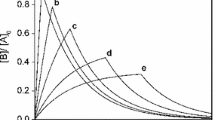Abstract
The prevalence of apparently first-order kinetics of reactant disappearance in complex systems with many possible reaction pathways is usually attributed to the dominance of a single rate limiting step. Here, we investigate another possible explanation: that apparently first-order kinetics might arise because the aggregate behavior of many processes, with varying order of reaction and rate constant, approaches a “central limit” that is indistinguishable from first-order behavior. This hypothesis was investigated by simulating systems of increasing complexity and deriving relationships between the apparent reaction order of such systems and various measures of their complexity. Transformation of a chemical species by parallel irreversible reactions that are zero-, first-, or second-order is found to converge to a central limit as the number of parallel reactions becomes large. When all three reaction orders are represented, on average, in equal proportions, this central limit is experimentally indistinguishable from first-order. A measure of apparent reaction order was used to investigate the nature of the convergence both stochastically and by deriving theoretical limits. The range of systems that exhibit a central limit that is approximately first-order is found to be broad. First-order like behavior is also found to be favored when the distribution of material among the parallel processes (due to differences in rate constants for the individual reactions) is more complex. Our results show that a first-order central limit exists for the kinetics of chemical systems and that the variable controlling the convergence is the physical complexity of reaction systems.
Similar content being viewed by others
References
A.M. Mood T.A. Graybill D.C. Boes (1974) Introduction to the Theory of Statistics EditionNumber3 McGraw-Hill New York
L.E. Reichl (1980) A Modern Course in Statistical Physics University of Taxas Press Austin, TX
D.T. Gillespie (2002) J. Phys. Chem. A 106 5063
H.A. Simon (1962) Proc. Am. Philos. Soc. 106 467
L. Poon C. Grebogi (1995) Phys. Rev. Lett. 75 4023
P. Grassberger (1986) Int. J. Theor. Phys. 25 907
K. Lindgren M.G. Nordahl (1988) Complex Syst. 2 409
D.P. Feldman J.P. Crutchfield (1998) Phys. Lett. A 238 244
P. Szépfalusy G. Györgyi (1986) Phys. Rev. A 33 2852
J.P. Crutchfield K. Young (1989) Phys. Rev. Lett. 63 105
J.P. Crutchfield (1994) Physica D 75 11
C.R. Shalizi J. P. Crutchfield (2001) J. Stat. Phys. 104 817
J.S. Shiner M. Davison P.T. Landsberg (1999) Phys. Rev. E 59 1459
C.E. Shannon (1948) Bell Syst. Tech. J. 27 379
W. Li (1991) Complex Syst. 5 381
W.H. Press B.P. Flannery S.A. Teukolsky et al. (1988) Numerical Recipes in C. The Art of Scientific Computing Cambridge University Cambridge, England
E.T. Urbansky (2001) J. Chem. Educ. 78 921
Author information
Authors and Affiliations
Corresponding author
Rights and permissions
About this article
Cite this article
Bandstra, J.Z., Tratnyek, P.G. Central limit theorem for chemical kinetics in complex systems. J Math Chem 37, 409–422 (2005). https://doi.org/10.1007/s10910-004-1107-y
Received:
Revised:
Issue Date:
DOI: https://doi.org/10.1007/s10910-004-1107-y



